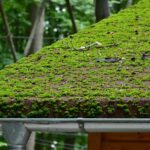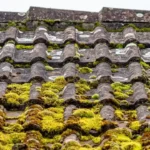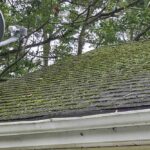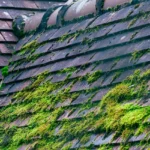If you’re noticing dark streaks and discoloration on your roof, you’re likely dealing with an unwelcome visitor: algae. Understanding how to treat algae on shingles is vital not just for maintaining the aesthetics of your home, but also for ensuring the longevity of your roof. Treating algae ensures that your home remains a welcoming and beautiful space. In this article, we’ll explore effective methods and tips for addressing algae growth on your roof shingles.

Understanding Algae on Roof Shingles
Algae, particularly Gloeocapsa Magma, is a type of cyanobacteria that thrives in humid and moist environments, often forming dark streaks on asphalt shingles. Homeowners often mistake these streaks for dirt or wear, but they are, in fact, living organisms that feed on the limestone filler used in shingles.
Why is Algae a Problem?
Algae on roofs not only detract from your home’s curb appeal but can also reduce the lifespan of your shingles. Over time, these microorganisms can retain moisture, leading to further damage and possibly mold growth.
Algae vs. Moss: Knowing the Difference
It’s important to note the difference between algae and moss. While algae appear as dark streaks, moss looks like thick green patches. Both need different treatment methods, which we’ll cover in this guide.
Preparation Before Treatment
Before you start, ensure you have the right equipment and safety precautions in place. This includes a sturdy ladder, safety harness, and protective gear.
Choose the Right Day for Cleaning
Select a cloudy day to clean the shingles. Direct sunlight can cause cleaning solutions to evaporate too quickly, reducing their effectiveness.
Steps to Treat Algae on Shingles
Here’s a step-by-step guide on how to treat algae on shingles:
Step 1: Gather Your Supplies
You will need a commercial roof cleaner or a DIY solution of bleach and water. Mix one part bleach with two parts water in a garden sprayer.
Step 2: Apply the Solution
Spray the solution over the affected areas. Ensure that you cover plants and shrubs around your home to protect them from the solution.
Step 3: Rinse the Roof
After about 15-20 minutes, thoroughly rinse the roof with water. Use a hose, as using a pressure washer can damage the shingles.
Preventing Future Algae Growth
After treatment, take steps to prevent future algae growth. Consider installing zinc or copper strips at the roof’s peak, as rain will wash small amounts across the roof, inhibiting algae growth.
Regular Inspections
Conduct regular roof inspections to catch algae growth early. Regular maintenance can avert expensive repairs in the future.
When to Call a Professional
If the algae coverage is extensive, or if your roof is steep or difficult to access, consider hiring a professional to handle the cleaning for you.
Environmental Considerations
Be mindful of the environmental impact of using chemical solutions. Opt for eco-friendly solutions whenever possible to protect the surrounding ecosystem.
Maintaining Your Roof’s Health
Beyond treating algae, ensure that you follow proper maintenance practices for overall roof health. Regular gutter cleaning and shingle repairs can help prolong your roof’s life.
Algae-Resistant Shingles
Consider investing in algae-resistant shingles when its time for a replacement. These shingles contain copper granules that prevent algae growth.

FAQs
Q: Can algae damage my shingles permanently?
A: Yes, if left untreated, algae can lead to weakened shingles and reduced lifespan.
Q: Are there any natural remedies for cleaning shingles?
A: Yes, vinegar and water mixtures can be a natural cleaning alternative to harsh chemicals.
Q: How often should I check my roof for algae?
A: Conduct inspections at least once a year, preferably after winter or heavy rain seasons.
In conclusion, understanding how to treat algae on shingles is essential for preserving the aesthetic and functional integrity of your roof. With regular maintenance and preventive measures, you can keep your roof algae-free and durable for years to come.
This article contains affiliate links. We may earn a commission at no extra cost to you.








